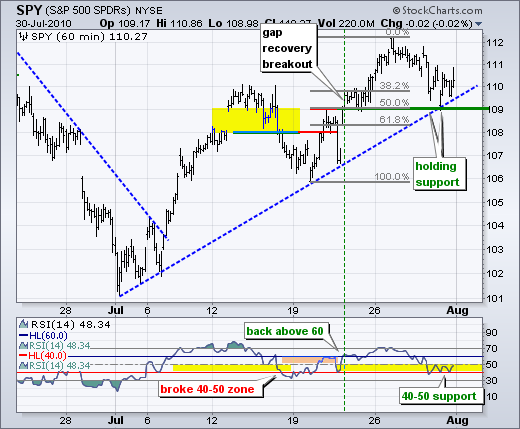After a big surge in July, the S&P 500 ETF (SPY) hit resistance around 112 and pulled back last week. Overall, SPY broke above the wedge trendline and exceeded its mid July high. These are bullish developments, but overbought conditions, key retracements and resistance kept stocks under pressure last week. Despite last week's pullback, the trendline break and July surge remain bullish overall. There is a big support zone around 106-108 that holds the key to the medium-term uptrend. This zone stems from the trendline extension and the mid July low. Even though RSI has yet to clearly break above 60, the momentum indicator is holding above 50 to keep a bullish bias.

On the 60-minute chart, SPY opened weak and recovered to affirm support at 109. Support at this level stems from the 50% retracement, July trendline and last week's lows. The short-term trend remains up as long as support at 109 holds. Frankly, SPY has had three chances to move sharply lower with three down gaps last week. Even though SPY was down last week, the decline has been rather orderly and the ETF managed to firm after the last two down gaps. A classic falling flag did not take shape, but the essence of the pattern is there. SPY retraced 50% of the mid July advance (106-112) with a pullback to around 109. Also notice that RSI is holding the support zone around 40-50. Until RSI breaks 40 and SPY breaks 109, I will expect the uptrend to continue.

Key Economic Reports:
Mon - Aug 02 - 10:00 - Construction Spending
Mon - Aug 02 - 10:00 - ISM Manufacturing Index
Tue - Aug 03 - 08:30 - Personal Income-Spending
Tue - Aug 03 - 10:00 - Factory Orders
Tue - Aug 03 - 10:00 - Pending Home Sales
Tue - Aug 03 - 14:00 - Auto-Truck Sales
Wed - Aug 04 - 10:00 - ISM Services Index
Wed - Aug 04 - 10:30 - Crude Inventories
Thu - Aug 05 - 08:30 - Jobless Claims
Fri - Aug 06 - 08:30 - Employment Report
Charts of Interest: None today.
This commentary and charts-of-interest are designed to stimulate thinking. This analysis is not a recommendation to buy, sell, hold or sell short any security (stock ETF or otherwise). We all need to think for ourselves when it comes to trading our own accounts. First, it is the only way to really learn. Second, we are the only ones responsible for our decisions. Think of these charts as food for further analysis. Before making a trade, it is important to have a plan. Plan the trade and trade the plan. Among other things, this includes setting a trigger level, a target area and a stop-loss level. It is also important to plan for three possible price movements: advance, decline or sideways. Have a plan for all three scenarios BEFORE making the trade. Consider possible holding times. And finally, look at overall market conditions and sector/industry performance.

About the author:
Arthur Hill, CMT, is the Chief Technical Strategist at TrendInvestorPro.com. Focusing predominantly on US equities and ETFs, his systematic approach of identifying trend, finding signals within the trend, and setting key price levels has made him an esteemed market technician. Arthur has written articles for numerous financial publications including Barrons and Stocks & Commodities Magazine. In addition to his Chartered Market Technician (CMT) designation, he holds an MBA from the Cass Business School at City University in London.
Learn More